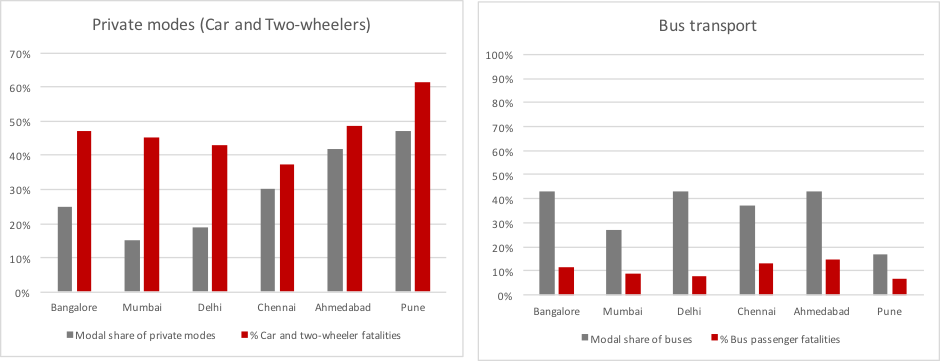Saving lives through investments in public bus systems
by -
India suffers from the highest burden of road crashes, contributing to nearly 10% of global road deaths. In just the last decade (2008-2017), road crashes in India have increased by 23%, with an average annual increase of about 2% every year. The problem is particularly acute in urban areas, which witness nearly 42% of all crashes in the country. Investing in public bus transport presents a significant opportunity to arrest this trend in cities, but has so far not been widely identified as a solution to road crashes in India.
Integrating the modal share data with the reported crash statistics for 6 cities in India, as presented in the figure below, shows us that bus passengers experience fewer fatalities than two-wheeler or car users when compared with the corresponding modal shares. However, most often, bus trips also include the first- and last-mile trips to and from the transit stops. Poorly designated and designed bus stops along with a lack of pedestrian infrastructure in the catchment areas create adverse conditions that lead to crashes between buses and vulnerable road users. As per figures by the Ministry of Road Transport and Highways, 47 State Road Transport Undertakings (SRTUs) together reported 4050 fatal crashes between April 2015 and March 2016. 263 (6.4%) of these crashes involved SRTUs plying in metropolitan cities, which operate 16.3% of total fleet and service about 8.8% of the total kilometers. Pedestrians and motorcyclists were the most impacted in such crashes.

Figure: A representation of modal share data integrated with the reported crash statistics for 6 cities in India.1
While buses are safer than private modes and bus-related road deaths amount to a small percentage of the total road deaths, bus crashes have impacts beyond the perceivable effects on public health. Even as unsafe road design and infrastructure is a predominant causal factor for crashes, without the means of scientific crash investigation, bus transit agencies share a majority of the burden. Our current statutory and regulatory loopholes allow for such omissions by not providing legal provisions to hold road planners, designers, and engineers proportionately accountable. Such unbalanced apportionment of liability can impact public’s perception of transit and, potentially, ridership. Moreover, road crashes are a drain on the limited finances that transit agencies have as they induce costs in terms of compensation to road crash victims, legal fees, vehicles damages, and loss of work hours.
Existing research shows that increasing usage of public bus transit can reduce traffic fatalities. However, to fully accrue the safety benefits of public bus transit, it is important to effectively manage the collateral road crash risks arising from it, which mostly impact vulnerable road users that share road space with buses. Without such parallel efforts, the impacts of transitioning to public bus transit systems can be limited, and the amplification of bus services could also amplify the collateral safety risks.
Measures to reduce crash risks associated with city buses
Nearly 70% of all bus-related fatalities involve motorcyclists and pedestrians. The third most-impacted category of victims is bus passengers. An analysis of bus crashes conducted by WRI India in partnership with Underwriters Laboratories revealed three prominent types of crash interactions involving city buses: a majority of pedestrian deaths happen while crossing the road in front of a bus; most two-wheeler deaths occur when a motorcycle’s handlebar comes into contact with the sides of a bus while traveling in the same direction as the bus; and a majority of passengers are killed during boarding and alighting.
In the short run, there is a need to focus on measures that are easily realizable and which significantly impact the safety of vulnerable road users. Most buses on our roads ply with substandard mirrors, resulting in reduced field of vision for drivers. Since 2016, WRI India has been working closely with a few bus transit agencies to replace substandard mirrors with good quality mirrors to reduce blind spots in buses. Trial runs conducted in Bangalore on 46 buses showed positive results, with nearly 80% of the drivers surveyed stating that the new mirrors improved driving experience. There is a need to scale up such measures and identify similar cost-effective solutions to address the problem urgently.
A long term solution to bus crashes, however, involves investing in our bus transit systems to make them a safe, efficient, and reliable mode of transport. Safe access to transit is critical for preventing the high number of pedestrian and passenger crashes. Bus stops, bus terminals and catchment areas should be redesigned to handle safe movement of pedestrians and bus passengers. Bus Rapid Transit (BRT) Systems, when well designed, can positively impact road safety in cities. The TransMilenio Bus Rapid Transit System in Bogota has reported over 50% reduction in traffic fatalities (on a corridor where this was implemented) during the first 9 years of its operation. BRT systems in Guadalajara and Melbourne reported similar decreases. However, such changes will ensue and sustain largely if the BRT systems incorporate safe design elements, allowing for lane segregation and improved pedestrian infrastructure.
Solving India’s road safety crisis requires fresh approaches, which include reforming the way we perceive and use public transport. An upfront investment into making our public bus transit systems safer is a significant step in the process of making them a plausible alternative to private modes. In the long term, return on such an investment will be improved road safety for all.
-
Sources: Traffic & Transportation Policies and Strategies in Urban Areas in India, Ministry of Urban Development (2008); Accidental Deaths and Suicides in India, National Crime Records Bureau (2015); Bus Karo 2.0, WRI India, 2015 ↩


